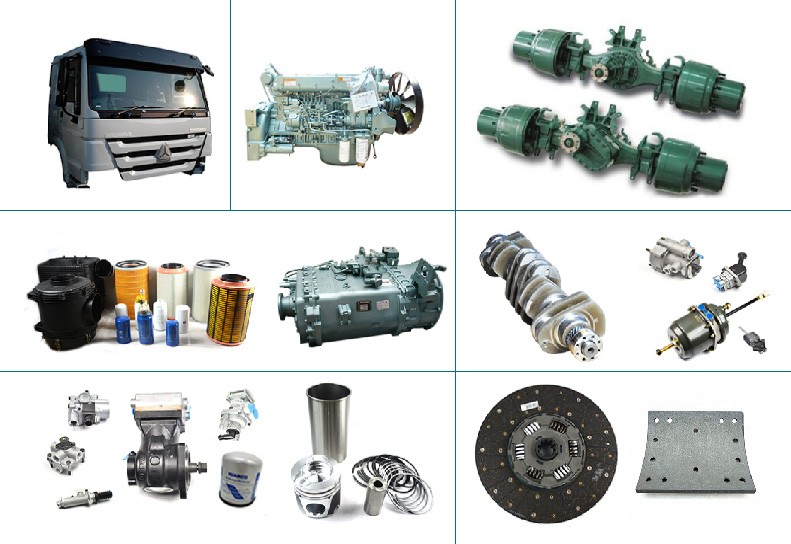Proper storage of truck parts is crucial for maintaining their condition. This article discusses best practices for storing Sinotruk and Shacman components.
When it comes to maintaining the longevity and functionality of truck parts, proper storage is crucial. Not only does it protect your investment, but it also ensures that components perform optimally when needed. Below, we delve deeper into effective practices for storing truck parts, focusing on cleanliness, appropriate containers, climate control, and organization.
Keep Parts Clean
Before storing any truck parts, cleanliness should be a top priority. Dust, dirt, and contaminants can lead to degradation or corrosion over time, ultimately affecting the part’s performance. Start by thoroughly cleaning each component using appropriate cleaning solutions and tools. For metal parts, consider using a degreaser to remove oil or grease, and follow up with a rinse to eliminate any residue. For plastic or rubber components, a mild soap solution can suffice.
Once cleaned, allow parts to dry completely to prevent moisture accumulation, which can promote rust or mold growth. Implementing a routine cleaning process before storage can go a long way in preserving the integrity of parts, especially for manufacturers like Sinotruk and Shacman, known for their high-performance standards. Keeping parts clean not only extends their lifespan but also enhances their reliability when put back into service.
Use Appropriate Containers
Selecting the right storage containers is vital for protecting truck parts from damage. Use sturdy, weather-resistant bins, shelves, or racks specifically designed for industrial storage. These containers help shield parts from environmental factors such as dust, moisture, and physical impacts that could occur during handling or storage.
For smaller components, consider using divided bins or tool organizers to prevent parts from rolling around or getting mixed up. Larger parts should be stored on pallets or heavy-duty shelves, ensuring they are elevated off the ground to avoid moisture accumulation. When storing hydraulic or electronic components, consider using anti-static bags to prevent static electricity from damaging sensitive parts. By utilizing appropriate containers, you maintain an organized storage space while protecting valuable components.
Control Temperature and Humidity
Temperature and humidity control are essential for preventing damage to truck parts. Extreme temperatures can lead to warping or cracking, particularly in rubber and plastic components, while high humidity can accelerate rust formation on metal parts. Ideally, truck parts should be stored in a climate-controlled environment where temperature fluctuations are minimized, and humidity levels are kept stable.
If a climate-controlled storage space is not feasible, consider using moisture absorbers, such as silica gel packs, to help control humidity levels within storage containers. Additionally, keeping storage areas well-ventilated can help reduce moisture buildup. Regularly monitor the environment with hygrometers and thermometers to ensure conditions remain within optimal ranges, typically between 50-70 degrees Fahrenheit and 30-50% relative humidity. By controlling temperature and humidity, you significantly reduce the risk of deterioration.
Label Storage Areas
Organization is key when it comes to maintaining an efficient storage system for truck parts. Labeling storage areas not only enhances organization but also makes it easier to locate specific components when needed. Use clear, durable labels that can withstand the conditions of your storage area, and ensure they are easily readable.
Implement a logical labeling system that groups parts by type, size, or function. For example, you might categorize labels by engine components, electrical parts, or hydraulic systems. This level of organization saves time during maintenance, as technicians can quickly find the required part without sifting through disorganized storage. Additionally, consider creating an inventory list that correlates with your labeling system, allowing for easy tracking of parts. An organized storage system reduces frustration and increases efficiency during maintenance and repairs.
Conclusion
Proper storage practices for truck parts are essential for maintaining their condition and ensuring optimal performance. By keeping parts clean, using appropriate containers, controlling temperature and humidity, and labeling storage areas, you can significantly extend the lifespan of components, including those from Sinotruk and Shacman. These practices not only protect your investment but also contribute to the overall efficiency of maintenance operations. Implementing these strategies will help you avoid costly repairs and downtime, ultimately leading to better performance and reliability in your trucking operations. Prioritizing the storage of truck parts is a vital aspect of vehicle maintenance that shouldn’t be overlooked.




